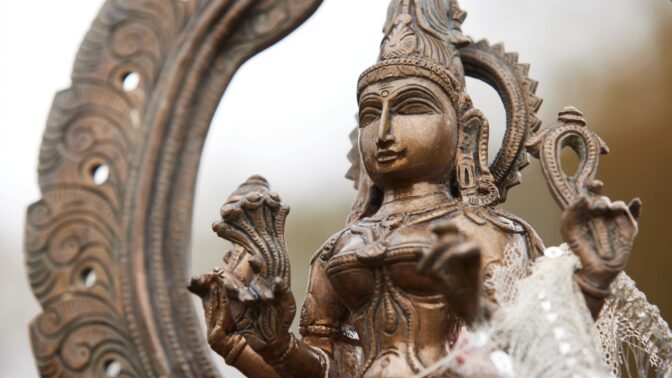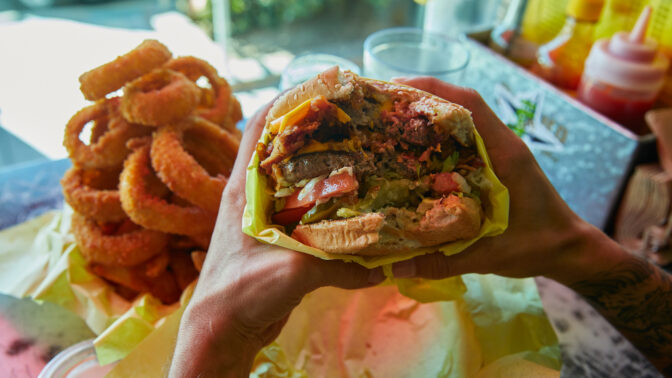In the '90s, weed became cool again. And so did the movies.
As the 1980s gave way to the final decade of the 20th century, a generation that came of age under the thumb of Nixon's war on drugs and the Just Say No era of the Reagans became activists and advocates for cannabis. They also started making dope movies — creating a new pop culture canon and expanding the language of cinema, making major contributions to the rise of weed in mainstream American culture.
As new coalitions of pro-pot activists such as Dennis Peron and Mary Jane Rathburn were building momentum in the San Francisco Bay Area by founding the first U.S. cannabis dispensary and making brownies for HIV and AIDS patients; hot new filmmakers including Richard Linklater, Quentin Tarantino, and F. Gary Gray were infusing their movies with some sneaky, but highly influential on-screen representation of the contemporary weed culture — while pioneering a collective technical dankness that would define the aesthetic of “'90s cool.”
As a result, just about every cool movie (and, honestly, most great movies) from the decade was, whether intentionally or not, playing to the stoners in the back corner. From the golden-age '90s stoner comedies to the stoney films of the decade's young rockstar directors, let's drop in on a brief timeline of the decade's raddest movies to see just how much we owe to weed for inciting a stoner cinema explosion that still resonates two decades later.
1993 — 'True Romance' and 'Dazed and Confused'
Quentin Tarantino's reign over pop culture in the '90s began with “True Romance,” a film that, though directed by Tony Scott, “True Romance” is largely thought of as a Tarantino joint. And why wouldn't it be? “True Romance” spares next to none of the usual Tarantino trappings — snappy back-and-forth dialogue riddled with '70s pop-culture references, genre-bending flourishes, and flash-in-the-pan performances from a heavy arsenal of colorful characters.
One such performance comes from a young, weird, and insanely hot Brad Pitt as Floyd — the couch-dwelling, pot-smoking roommate of another secondary character, and the inspiration for James Franco's Saul in “Pineapple Express” (Franco has said on record that the whole idea for the 2008 buddy action/stoner comedy mashup originated with the Floyd character).
In retrospect, it's almost jarring to watch Pitt's pre-fame cameo role in “True Romance,” and it's even stranger to think how quickly this burnout/supermodel weirdo, offering bong rips to gangsters who force themselves into his Hollywood apartment, would become our biggest and brightest movie star.
If Floyd was a prototype for the Gen-X stoner, then Richard Linklater's “Dazed and Confused” is ground zero for the entire concept of stoner cinema as we know it today — drawing from the vibes of past stoner comedies like “Up in Smoke” and “Fast Times at Ridgemont High” while expanding the parameters of what a stoner comedy could be.
“Dazed and Confused” has been hailed by Tarantino as the ultimate “hangout movie,” one you go back to again and again to hang around 1970s stoner characters, cruising through the last day of high school and first night of summer with a joint in hand.
Author Chuck Klosterman famously wrote of the film, “I have watched 'Dazed and Confused' approximately 65 times, and I have been stoned for approximately 64 of those viewings. At this point, it seems unfathomable to watch this movie without being high.” On an episode of The Ringer's “Rewatchables” podcast celebrating the film's 25th anniversary, Bill Simmons also talked about all the hidden-gem moments of the film you only notice if you watch it with “stoned goggles” on.
There's no crime in enjoying “Dazed and Confused” while not under the influence (at least not in states where medical or adult use is allowed), but in the words of Matthew McConaughey's Wooderson, “it'd be a lot cooler if you did.”
1995 — 'Friday'
In similar fashion to “Dazed,” 'Friday” is a day-in-the-life story with a sparse plot, plenty of memorable vignettes, and a cast of characters you want to smoke a joint and hang out with again and again. It's a hip, blunt instrument that feels completely fresh, but it also wears its stoner-movie influences on its sleeve. When the movie treats us to quick sesh in the bedroom of Chris Tucker's Smokey (another star-making role), the camera takes ample time to highlight walls adorned with Cheech & Chong, Cypress Hill, and various other classic stoner posters — a visual passing of the torch from the counterculture of the '60s and '70s to the growing pro-pot sentiment of the '90s.
“Friday” also presents a raw, unflinching look at the cannabis users of '90s black America through a stoner comedy lens.
Before “Friday,” movies about the black experience in South Central Los Angeles had been having a moment. And they were serious business — something “Friday” co-writers Ice Cube and DJ Pooh wanted to change up with their movie.
“In the hood, they was doing movies like 'Boyz N the Hood,' which I did, 'Menace II Society,' 'South Central,' and even 'Colors,' going back that far,” Ice Cube said in Complex's oral history of the film. “Everybody was looking at our neighborhood like it was hell on Earth, like the worst place you can grow up in America. And I'm like, “Why?” I didn't see it all that way. We [Cube and DJ Pooh] in the studio laughing all day, smoking weed, and we were just like, 'Yo, we need to create something to show how the hood really is, from our vantage point.'”
By infusing an authentic story of life in the hood with resonant stoner humor, Cube, Pooh, and director F. Gary Gray set a collective standard for all stoner stoner comedies that came after. No matter how silly the humor got or how much they would have to pander to cartoonish stereotypes to rope in a mainstream audience, the '90s stoner comedy needed to have something interesting to say about its subject, and it needed to confront long-standing misconceptions about weed from the previous decades of propaganda.
1997 — 'Jackie Brown'
By the time we get to the latter half of the '90s, the hippest directors of the decade are taking the hangout-movie template of groundbreaking stoner comedies like “Dazed” and “Friday” and Hollywood's hippest sector of filmmaking is now knocking on the door of the stoner world, rather than the other way around. Exhibit A: Quentin Tarantino's “Jackie Brown.”
Is “Jackie Brown” a stoner movie in the strictest sense? Probably not, but it is a prime example of '90s Hollywood changing with the times by adopting stoner-movie sensibilities.
By the time Tarantino made “Jackie Brown,” he had already marked his territory as the last rockstar Hollywood director. He could have gone in virtually any direction with his follow-up, and he chose to make a hangout movie. And it ticks all the important '90s stoner movie boxes. It's retro-pop soundtrack is a constant presence, and it's structure favors individual scenes over plotting.
Subbing in for Brad Pitt's Floyd in “True Romance” is '90s fave Bridget Fonda as Melanie, the film's stoner avatar. Fonda's magnetic performance as the stoner who's also secretly the smartest person in the room is a major highlight of “Jackie Brown,” and should have earned her a stoner-icon gold status she never quite got. The movie also does some serious against-type stunt casting with Robert DeNiro, whose awkward burnout small-time criminal Louis is more comfortable hitting the bong with Melanie than he is taking part in the film's central heist.
1998 — 'Half Baked' and 'The Big Lebowski'
Think of 1998 as the year that pot broke the movies. It's the year of “Half Baked,” the stoner comedy that, perhaps even more so than “Friday,” paved the way for “How High,” “Super Troopers,” “Dude, Where's My Car?” and every other stoner comedy of the 2000s. 1998 also gave us “The Big Lebowski,” which introduced us to the Dude, the stoner icon to end all stoner icons, in a film that's equal parts stoner flick and arthouse genre masterpiece.
“Half Baked,” written by and starring Dave Chapelle as the leader of a group of really dumb stoners who hatch a series of cartoonish schemes to get their friend out of jail, is a far cray from “Friday” in many respects. It does a lot to establish some stoner comedy tropes that feel like pandering today, but it does even more to normalize cannabis use over a decade before the rest of the world would even begin to catch up. The movie's “different types of smokers” montage is a first-class early attempt to portray weed as a normal part of everyday American life.
“Half Baked” is also chock full of dialogue that addresses the “gateway drug” myth, and builds an entire scene around distinguishing between drugs and weed, a sentiment we now take for granted in the legalization era.
Since the days of Cheech & Chong, the stoner comedy has always skirted the line between exploitation and subversion. In '98, “Half Baked” continued that tradition and propelled it into the next decade. That same year, the Coen Brothers inadvertently created a stoner buddha who would all but bend the iconography of weed to reflect his image.
When we hear the term “stoner movie,” we'll probably always think of stoner comedies like “Up in Smoke,” “Friday,” and “Half Baked” first. But when we think of stoner icons, “The Big Lebowski”'s the Dude will always abide. “The Big Lebowski” is a brilliantly executed, zeitgeist capturing multi-genre hangout flick. It also shares a propensity for trippy dream sequences in common with “Half Baked.”But rather than have its stoner avatar on the periphery of the action, it casts the Dude (an aging Vietnam-era pothead comfortably meandering through 1990s Los Angeles, who could only have been brought to life by the eternally chill cowboy that is Jeff Bridges) at the center of the universe. And the rest of the movie all but marinates in the dude's stoned-zen essence — favoring hazy excursions through relaxed-fit vignettes over the drive of its own neo-noir mystery.
With the Dude, the Coen Brothers created a character so magnetic that their movie essentially became a stoner movie around him in real time. But “The Big Lebowski” has its own cult status that transcends its stoner-movie status, and the Dude has become a towering modern figure in both weed culture and cinema history.
In this sense, he personifies the entire stoner cinema movement of the '90s, bridging the gap between weed enthusiasts and the rest of the world — inviting everyone to tune in, light up, and chill out.
To learn more about how '90s films intersected with cannabis culture in the U.S., check out the “Dose of Compassion” exhibit at the Weedmaps Museum of Weed. For ticket information, visit themusumeofweed.com.
Feature illustration by David Lozada/Weedmaps





